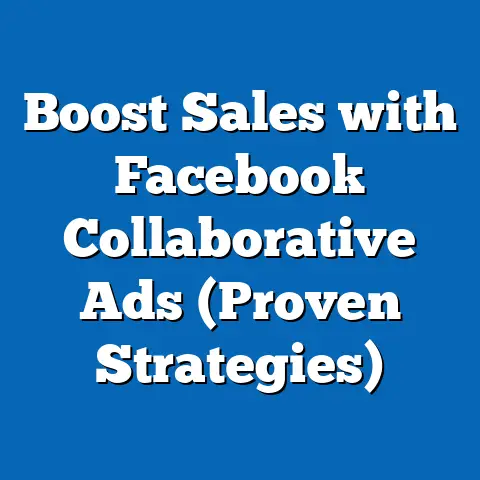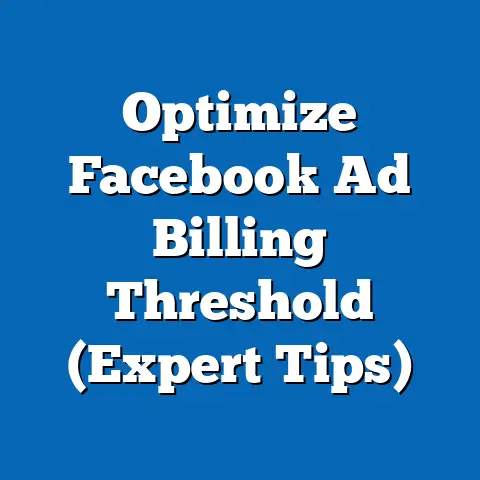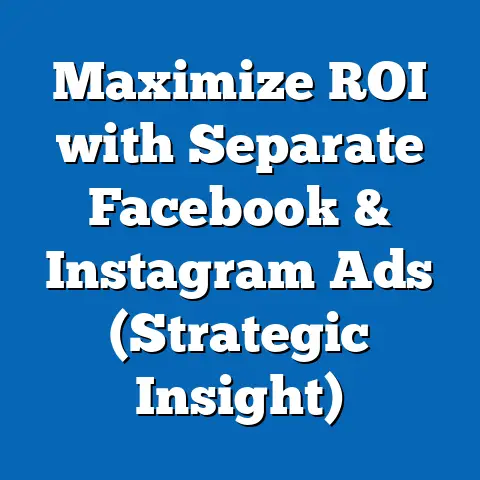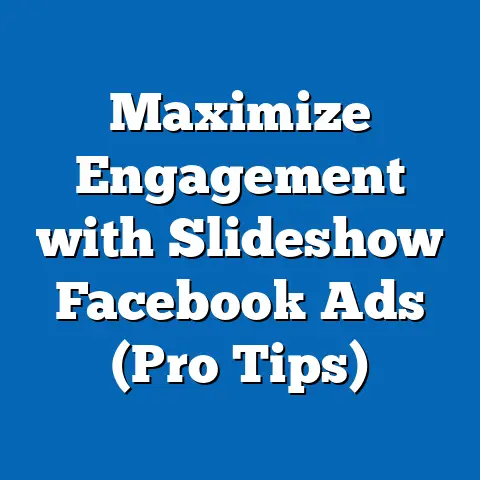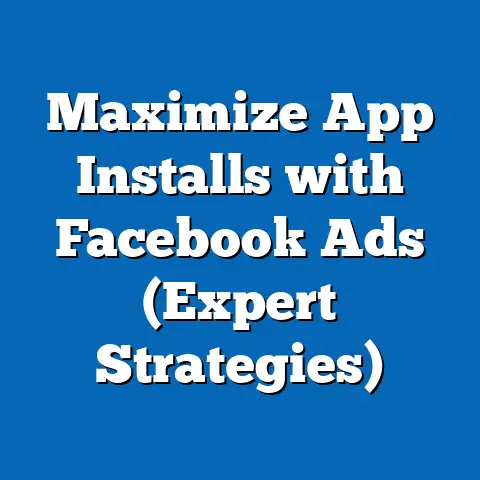Optimize Facebook Ad Text Ratio (Expert Tips)
Facebook ads are an undeniable force in today’s digital marketing landscape. As someone who’s spent years crafting and analyzing countless campaigns, I can tell you firsthand that a well-optimized Facebook ad can be the difference between a thriving business and one that’s struggling to get noticed. But with so much noise online, how do you make your ads stand out? The secret lies in the details, particularly in the way you balance text with visuals – the “text ratio.”
The text ratio in your Facebook ads is more than just a design consideration; it’s a crucial element that affects how your audience perceives your message and how Facebook’s algorithm evaluates your ad. It’s about creating a harmony between captivating visuals and persuasive text that stops the scroll and drives action. And the best part? Optimizing your ad text isn’t about being a design guru or a marketing genius. It’s about understanding a few key principles and applying them consistently.
Section 1: Understanding Facebook Ad Text Ratio
Let’s start with the basics. What exactly do I mean when I talk about “text ratio” in the context of Facebook ads?
Defining Text Ratio in Facebook Ads
In simple terms, the text ratio is the proportion of text compared to the image or video in your Facebook ad. It’s the balance between the words you use to communicate your message and the visual elements you use to capture attention. This includes the headline, body text, description, and any text embedded within the image or video itself.
Think of it like this: you’re trying to tell a story. The image or video is the main visual, setting the scene and grabbing the viewer’s interest. The text is the supporting narrative, providing context, highlighting key benefits, and guiding the viewer towards the desired action.
The Significance of Balancing Text with Images and Videos
Why is this balance so important? Because in the fast-paced world of social media, you have mere seconds to make an impression. A cluttered ad with too much text can be overwhelming and off-putting, causing viewers to scroll right past it. On the other hand, an ad with too little text might not effectively communicate your message or provide enough information to entice users to click.
The right balance ensures that your ad is visually appealing, easy to understand, and persuasive. It helps you capture attention, convey your message clearly, and drive the desired action, whether that’s visiting your website, making a purchase, or signing up for a newsletter.
How Facebook’s Algorithm Evaluates Ad Text and Its Impact on Ad Performance
But the importance of text ratio goes beyond just visual appeal. Facebook’s algorithm also plays a crucial role. Back in the day, Facebook had a strict “20% text rule,” meaning that if your ad image contained more than 20% text, it would be penalized and its reach would be limited. While this rule has been officially retired, the underlying principle remains: Facebook favors ads that provide a good user experience.
The algorithm analyzes various factors, including the amount of text in your ad, its readability, and its relevance to the target audience. Ads with excessive or poorly written text are often seen as low-quality and may be penalized with lower reach, higher costs, and reduced performance.
I’ve seen this firsthand in my own campaigns. I once ran two similar ads for a client, one with a concise headline and a clear call-to-action, and the other with a lengthy, descriptive headline. The first ad significantly outperformed the second, achieving a higher click-through rate and lower cost per click. This experience taught me the importance of keeping my ad text concise and focused.
The Ideal Text-to-Image Ratio According to Facebook’s Best Practices
So, what’s the ideal text-to-image ratio? While Facebook no longer enforces a strict 20% rule, it’s still a good guideline to follow. Aim to keep the text in your ad image to a minimum, ideally less than 20% of the image area.
Focus on using the visual elements to tell your story and capture attention, and use the text to provide essential information and guide the viewer towards the desired action. Keep your headlines short and catchy, your body text concise and persuasive, and your call-to-action clear and compelling.
Examples of Successful Ads That Effectively Balance Text and Visuals
To illustrate this point, let’s look at some examples of successful ads that effectively balance text and visuals:
- Airbnb: Their ads often feature stunning photos of unique accommodations with minimal text highlighting the location and a clear call-to-action like “Explore Now.”
- Nike: They use powerful visuals of athletes in action with short, inspiring slogans that resonate with their target audience.
- Dollar Shave Club: Their ads are known for their humorous videos with witty voiceovers that clearly communicate their value proposition.
These examples demonstrate that you don’t need a lot of text to create an effective ad. By focusing on high-quality visuals and concise, persuasive copy, you can capture attention, convey your message, and drive results.
Key Takeaway: Understanding the text ratio and its impact on ad performance is crucial for creating effective Facebook ads. Aim to balance text with visuals, keep your ad text concise and focused, and prioritize user experience to improve your ad’s reach, engagement, and overall performance.
Section 2: Key Factors Affecting Text Ratio
Now that we understand the importance of text ratio, let’s explore the key factors that can affect it and how to optimize your ads accordingly.
The Role of Audience Demographics and Targeting in Text Optimization
Your target audience plays a significant role in determining the optimal text ratio for your ads. Different demographics and interests may respond differently to various types of ad copy and visuals.
For example, if you’re targeting a younger audience, you might want to use more informal language, emojis, and visually appealing graphics to capture their attention. On the other hand, if you’re targeting a more professional audience, you might want to use more formal language, professional imagery, and focus on highlighting the key benefits of your product or service.
I’ve learned this lesson the hard way. I once ran a campaign targeting both young adults and middle-aged professionals with the same ad copy. The results were disappointing. The younger audience responded well to the informal language and trendy visuals, but the professionals found it unprofessional and irrelevant. By segmenting my audience and tailoring my ad copy accordingly, I was able to significantly improve the campaign’s performance.
How Ad Objectives (Brand Awareness, Conversions, etc.) Influence Text Ratio
Your ad objective also influences the optimal text ratio. If your goal is to increase brand awareness, you might want to focus on using visually appealing images or videos with minimal text to capture attention and create a memorable impression.
Analyzing How Different Ad Placements (News Feed, Stories, etc.) Require Varied Text Ratios
Facebook offers various ad placements, including the news feed, stories, right column, and in-stream videos. Each placement has its own unique characteristics and requires a different approach to text ratio optimization.
For example, in the news feed, you have more space to display text and visuals, allowing you to provide more detailed information about your product or service. In stories, you have limited space and attention span, so you need to focus on using visually appealing graphics with minimal text to capture attention quickly.
I’ve found that using different ad creatives for different placements can significantly improve campaign performance. For example, I often use short, attention-grabbing videos with minimal text for stories, and longer, more informative ads with a higher text ratio for the news feed.
Case Studies or Statistics Demonstrating the Correlation Between Text Ratio and Ad Performance
Numerous case studies and statistics demonstrate the correlation between text ratio and ad performance. For example, a study by HubSpot found that ads with concise headlines (6-12 words) achieved a 26% higher click-through rate than ads with longer headlines.
Another study by Neil Patel found that ads with clear and concise ad copy generated 83% more leads than ads with vague or confusing ad copy. These studies highlight the importance of optimizing your text ratio to improve your ad’s performance.
Key Takeaway: Understanding the factors that affect text ratio, such as audience demographics, ad objectives, and ad placements, is crucial for optimizing your Facebook ads for maximum impact. Tailor your ad copy and visuals to your target audience, align your text ratio with your ad objective, and optimize your ads for each specific placement to improve your ad’s reach, engagement, and overall performance.
Section 3: Crafting Compelling Ad Copy
Now that we’ve covered the basics of text ratio and the factors that affect it, let’s dive into the art of crafting compelling ad copy. This is where you can truly make your ads shine and connect with your target audience on a deeper level.
- Know Your Audience: Understand their needs, desires, and pain points. Use language that they understand and that speaks directly to their interests.
- Highlight Key Benefits: Focus on the value that your product or service provides. What problems does it solve? How will it improve their lives?
- Use Strong Verbs and Action Words: Create a sense of urgency and excitement. Encourage users to take action.
- Keep It Short and Sweet: Avoid long, rambling sentences. Get straight to the point.
- Use Emojis Sparingly: Emojis can add personality and visual appeal to your ads, but don’t overdo it. Use them strategically to highlight key points or add emotion.
The Importance of Using a Strong Call-to-Action (CTA) and Where to Place It Within the Text
A strong call-to-action (CTA) is essential for driving conversions. It tells users exactly what you want them to do and encourages them to take the desired action. Here are some tips for crafting effective CTAs:
- Be Clear and Specific: Use action-oriented language that leaves no room for ambiguity. Examples include “Shop Now,” “Learn More,” “Sign Up Today,” and “Get Started.”
- Create a Sense of Urgency: Use words like “Now,” “Today,” or “Limited Time Offer” to encourage users to act quickly.
- Make It Visually Appealing: Use a button or a contrasting color to make your CTA stand out.
- Place It Prominently: Make sure your CTA is easy to find and click. Consider placing it at the end of your ad copy or within the ad image.
Highlighting the Use of Emotional Triggers and Persuasive Language
Emotional triggers and persuasive language can be powerful tools for capturing attention and driving conversions. Here are some common emotional triggers that you can use in your ad copy:
- Fear of Missing Out (FOMO): Create a sense of scarcity or exclusivity to encourage users to act quickly.
- Social Proof: Highlight positive reviews, testimonials, or user-generated content to build trust and credibility.
- Sense of Belonging: Emphasize the community aspect of your product or service to make users feel like they’re part of something bigger.
- Nostalgia: Evoke positive memories and emotions from the past to connect with users on a deeper level.
Examples of Effective Ad Copy That Illustrates These Concepts
Let’s look at some examples of effective ad copy that illustrates these concepts:
- “Don’t Miss Out! Shop Our Limited-Time Sale and Save Up to 50% Off. Shop Now!” (Uses FOMO and a clear CTA)
- “Join Our Community of Over 1 Million Happy Customers. See What Everyone’s Talking About. Learn More!” (Uses social proof and a sense of belonging)
- “Remember the Good Old Days? Relive Your Childhood with Our Classic Games. Get Started Today!” (Uses nostalgia and a clear CTA)
Key Takeaway: Crafting compelling ad copy is essential for capturing attention, conveying your message, and driving conversions. Be concise, clear, and persuasive. Use a strong call-to-action, emotional triggers, and persuasive language to connect with your target audience on a deeper level.
Section 4: A/B Testing Your Ad Text
Now that you know how to craft compelling ad copy, it’s time to put your skills to the test. A/B testing, also known as split testing, is a powerful technique for optimizing your Facebook ads and improving their performance.
Explaining What A/B Testing Is and Its Relevance to Optimizing Facebook Ads
A/B testing involves creating two or more versions of your ad (A and B) with slight variations in the text, visuals, or targeting. You then run these ads simultaneously and track their performance to see which version performs better.
A/B testing is crucial for optimizing your Facebook ads because it allows you to make data-driven decisions based on real-world results. Instead of relying on guesswork or intuition, you can test different ad elements and see what resonates best with your target audience.
Detailing How to Set Up A/B Tests Specifically for Ad Text and Variations in Text Ratio
Setting up A/B tests for ad text and variations in text ratio is relatively straightforward. Here’s a step-by-step guide:
- Create Two or More Ad Variations: Start by creating two or more versions of your ad with slight variations in the text, headline, description, or call-to-action. You can also test different text ratios by varying the amount of text in the ad image.
- Use Facebook’s A/B Testing Tool: Facebook’s Ad Manager has a built-in A/B testing tool that makes it easy to set up and run split tests. Simply select the “A/B Test” option when creating your ad campaign.
- Define Your Test Variables: Choose the specific ad elements that you want to test, such as headline, body text, call-to-action, or text ratio.
- Set Your Budget and Schedule: Determine how much you want to spend on the A/B test and how long you want to run it.
- Launch Your Test: Once you’ve configured your settings, launch your A/B test and let it run for a few days or weeks, depending on your budget and traffic volume.
Discussing Metrics to Track During A/B Testing to Determine Success (CTR, Engagement Rates, etc.)
During your A/B test, it’s crucial to track the right metrics to determine which ad version is performing better. Here are some key metrics to consider:
- Click-Through Rate (CTR): The percentage of people who click on your ad after seeing it. A higher CTR indicates that your ad is more engaging and relevant to your target audience.
- Conversion Rate: The percentage of people who take the desired action after clicking on your ad, such as making a purchase, signing up for a newsletter, or filling out a form. A higher conversion rate indicates that your ad is more effective at driving results.
- Cost Per Click (CPC): The amount you pay each time someone clicks on your ad. A lower CPC indicates that your ad is more efficient at driving traffic.
- Engagement Rate: The percentage of people who interact with your ad, such as liking, commenting, or sharing it. A higher engagement rate indicates that your ad is more engaging and resonates with your target audience.
Sharing Success Stories From Brands That Have Used A/B Testing to Refine Their Ad Text
Many brands have achieved significant results by using A/B testing to refine their ad text. For example, a case study by Optimizely found that a leading e-commerce brand increased its conversion rate by 25% by A/B testing different headlines and calls-to-action.
Another case study by Unbounce found that a SaaS company increased its lead generation rate by 31% by A/B testing different ad copy and visuals. These success stories highlight the power of A/B testing for optimizing your Facebook ads and improving their performance.
Key Takeaway: A/B testing is a powerful technique for optimizing your Facebook ads and improving their performance. Set up A/B tests for your ad text and variations in text ratio, track the right metrics, and use the results to make data-driven decisions that improve your ad’s reach, engagement, and overall performance.
Section 5: Tools and Resources for Optimization
Optimizing your Facebook ad text ratio doesn’t have to be a daunting task. There are plenty of tools and resources available to help you streamline the process and achieve better results.
Listing Popular Tools and Software That Can Assist in Optimizing Facebook Ad Text
Here are some popular tools and software that can assist you in optimizing your Facebook ad text:
- Headline Analyzer Tools: These tools analyze your headlines and provide feedback on their readability, emotional impact, and overall effectiveness. Examples include CoSchedule Headline Analyzer and Sharethrough Headline Analyzer.
- Grammar Checkers: These tools help you identify and correct grammar errors, spelling mistakes, and punctuation issues in your ad copy. Examples include Grammarly and ProWritingAid.
- Readability Scorers: These tools assess the readability of your ad copy and provide a score based on factors like sentence length, word complexity, and overall clarity. Examples include the Flesch-Kincaid Readability Test and the Gunning Fog Index.
- Character Counters: These tools help you keep track of the character count in your headlines and descriptions to ensure that they meet Facebook’s requirements. Examples include LetterCount and Character Count Tool.
Discussing How to Use Facebook’s Ad Manager for Insights on Text Performance
Facebook’s Ad Manager is a valuable resource for gaining insights into the performance of your ad text. The Ad Manager provides detailed data on metrics like click-through rate, conversion rate, cost per click, and engagement rate, allowing you to see how your ad text is performing and identify areas for improvement.
You can also use the Ad Manager to run A/B tests, track your results, and make data-driven decisions about your ad copy.
Introducing Tools for Grammar Checking, Readability Scoring, and Character Count to Ensure Compliance With Facebook Standards
As mentioned earlier, grammar checkers, readability scorers, and character counters are essential tools for ensuring that your ad text is clear, concise, and compliant with Facebook’s standards.
Using these tools can help you avoid common mistakes, improve the readability of your ad copy, and ensure that your headlines and descriptions meet Facebook’s character limits.
Suggesting Resources for Staying Updated on Facebook Advertising Trends and Best Practices
The world of Facebook advertising is constantly evolving, so it’s crucial to stay updated on the latest trends and best practices. Here are some resources that can help you stay informed:
- Facebook’s Official Blog: Facebook’s official blog provides updates on new features, platform changes, and advertising best practices.
- Industry Blogs: Follow industry blogs like Social Media Examiner, HubSpot, and Neil Patel’s blog for insights on Facebook advertising trends and strategies.
- Online Courses: Take online courses on platforms like Coursera and Udemy to learn advanced Facebook advertising techniques.
- Industry Conferences: Attend industry conferences like Social Media Marketing World and AdWorld to network with other marketers and learn from experts.
Key Takeaway: There are plenty of tools and resources available to help you optimize your Facebook ad text ratio. Use headline analyzer tools, grammar checkers, readability scorers, and character counters to ensure that your ad copy is clear, concise, and compliant with Facebook’s standards. Stay updated on the latest trends and best practices by following industry blogs, taking online courses, and attending industry conferences.
Section 6: Real-world Examples and Case Studies
To further illustrate the importance of optimizing your Facebook ad text ratio, let’s examine some real-world examples and case studies of brands that have successfully implemented these strategies.
Presenting a Few Real-World Examples of Brands That Successfully Optimized Their Facebook Ad Text Ratio
- Dollar Shave Club: As I mentioned earlier, Dollar Shave Club is known for their humorous videos with witty voiceovers that clearly communicate their value proposition. They use minimal text in their ad images, relying on the video to capture attention and convey their message. This strategy has helped them build a strong brand and acquire millions of customers.
- Airbnb: Airbnb’s ads often feature stunning photos of unique accommodations with minimal text highlighting the location and a clear call-to-action like “Explore Now.” They focus on using high-quality visuals to capture attention and create a sense of wanderlust.
- Nike: Nike uses powerful visuals of athletes in action with short, inspiring slogans that resonate with their target audience. They focus on using emotion and storytelling to connect with users on a deeper level.
Analyzing the Specific Strategies These Brands Used and the Results They Achieved
These brands have achieved success by following a few key principles:
- Focus on Visuals: They prioritize high-quality visuals that capture attention and tell a story.
- Keep Text Concise: They use minimal text to highlight key benefits and guide users towards the desired action.
- Know Their Audience: They understand their target audience’s needs, desires, and pain points and tailor their ad copy accordingly.
- Use Strong CTAs: They use clear and compelling calls-to-action that encourage users to take the desired action.
Discussing Lessons Learned From These Case Studies That Readers Can Apply to Their Own Campaigns
Here are some lessons learned from these case studies that you can apply to your own campaigns:
- Prioritize Visuals: Invest in high-quality visuals that capture attention and tell a story.
- Keep Text Concise: Use minimal text to highlight key benefits and guide users towards the desired action.
- Know Your Audience: Understand your target audience’s needs, desires, and pain points and tailor your ad copy accordingly.
- Use Strong CTAs: Use clear and compelling calls-to-action that encourage users to take the desired action.
- Test and Iterate: Continuously test different ad elements and iterate on your strategies based on the results.
Key Takeaway: By studying real-world examples and case studies, you can gain valuable insights into how to optimize your Facebook ad text ratio for maximum impact. Follow the principles outlined above and continuously test and iterate on your strategies to achieve better results.
Conclusion
Optimizing your Facebook ad text ratio is a crucial step towards achieving better ad performance and maximizing your ROI. By understanding the principles outlined in this guide, you can create ads that capture attention, convey your message effectively, and drive the desired action.
Remember to balance text with visuals, keep your ad text concise and focused, and prioritize user experience. Tailor your ad copy and visuals to your target audience, align your text ratio with your ad objective, and optimize your ads for each specific placement.
Use A/B testing to refine your ad text and variations in text ratio, track the right metrics, and make data-driven decisions. Leverage the tools and resources available to help you streamline the optimization process and stay updated on the latest trends and best practices.
And finally, learn from real-world examples and case studies to gain valuable insights into how to optimize your Facebook ad text ratio for maximum impact.
By implementing these expert tips and strategies, you can create Facebook ads that truly resonate with your target audience and achieve your advertising goals.
Call to Action
Now it’s your turn! I encourage you to share your own experiences or questions about optimizing Facebook ad text ratio in the comments section below. What strategies have worked best for you? What challenges have you faced?
And if you found this guide helpful, be sure to follow my blog for more insights on digital marketing and Facebook advertising strategies. Let’s continue the conversation and help each other succeed in the ever-evolving world of Facebook advertising!

